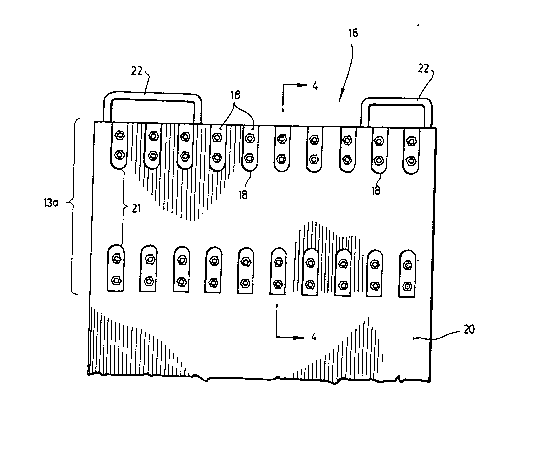Une partie des informations de ce site Web a été fournie par des sources externes. Le gouvernement du Canada n'assume aucune responsabilité concernant la précision, l'actualité ou la fiabilité des informations fournies par les sources externes. Les utilisateurs qui désirent employer cette information devraient consulter directement la source des informations. Le contenu fourni par les sources externes n'est pas assujetti aux exigences sur les langues officielles, la protection des renseignements personnels et l'accessibilité.
L'apparition de différences dans le texte et l'image des Revendications et de l'Abrégé dépend du moment auquel le document est publié. Les textes des Revendications et de l'Abrégé sont affichés :
| (12) Brevet: | (11) CA 2061864 |
|---|---|
| (54) Titre français: | DISPOSITIF UTILISE POUR DEPLACER DES CHARGES LOURDES ET DE DIMENSIONS CONSIDERABLES |
| (54) Titre anglais: | DEVICE FOR MOVING LARGE AND HEAVY LOADS |
| Statut: | Périmé et au-delà du délai pour l’annulation |
| (51) Classification internationale des brevets (CIB): |
|
|---|---|
| (72) Inventeurs : |
|
| (73) Titulaires : |
|
| (71) Demandeurs : |
|
| (74) Agent: | ROBIC AGENCE PI S.E.C./ROBIC IP AGENCY LP |
| (74) Co-agent: | |
| (45) Délivré: | 1996-08-27 |
| (22) Date de dépôt: | 1992-02-26 |
| (41) Mise à la disponibilité du public: | 1993-08-27 |
| Requête d'examen: | 1992-02-26 |
| Licence disponible: | Oui |
| Cédé au domaine public: | S.O. |
| (25) Langue des documents déposés: | Anglais |
| Traité de coopération en matière de brevets (PCT): | Non |
|---|
| (30) Données de priorité de la demande: | S.O. |
|---|
A device for moving large and heavy apparatuses combining
modular rail sections positioned one after the other to form
two parallel rails onto which slides a load-carrying plate
extending transversally between the rails. The upper
surface of the rail section has a central row of upwardly
projecting supporting elements positioned at regular
intervals along its length. The undersurface of the carrying
plate has two opposite edge portions each having two
parallel rows of guiding elements projecting down and
positioned at regular intervals along its length. When the
plate is positioned on top of the rails, the two rows of
guiding elements define a guiding channel which may
releasably engage the central row of supporting elements
projecting up the corresponding rail. The upper layer of
each supporting elements and the bottom layer of each
guiding elements are made of a friction material, either low
friction material to facilitate movement therealong or high
friction material to enhance friction. Also, the central
row of supporting elements of the rails are sized to act as
retaining means for a hydraulic jack to push the carrying
plate.
Note : Les revendications sont présentées dans la langue officielle dans laquelle elles ont été soumises.
Note : Les descriptions sont présentées dans la langue officielle dans laquelle elles ont été soumises.

2024-08-01 : Dans le cadre de la transition vers les Brevets de nouvelle génération (BNG), la base de données sur les brevets canadiens (BDBC) contient désormais un Historique d'événement plus détaillé, qui reproduit le Journal des événements de notre nouvelle solution interne.
Veuillez noter que les événements débutant par « Inactive : » se réfèrent à des événements qui ne sont plus utilisés dans notre nouvelle solution interne.
Pour une meilleure compréhension de l'état de la demande ou brevet qui figure sur cette page, la rubrique Mise en garde , et les descriptions de Brevet , Historique d'événement , Taxes périodiques et Historique des paiements devraient être consultées.
| Description | Date |
|---|---|
| Le délai pour l'annulation est expiré | 2009-02-26 |
| Lettre envoyée | 2008-02-26 |
| Inactive : CIB de MCD | 2006-03-11 |
| Inactive : CIB de MCD | 2006-03-11 |
| Lettre envoyée | 2000-02-03 |
| Lettre envoyée | 1999-12-23 |
| Accordé par délivrance | 1996-08-27 |
| Demande publiée (accessible au public) | 1993-08-27 |
| Toutes les exigences pour l'examen - jugée conforme | 1992-02-26 |
| Exigences pour une requête d'examen - jugée conforme | 1992-02-26 |
Il n'y a pas d'historique d'abandonnement
| Type de taxes | Anniversaire | Échéance | Date payée |
|---|---|---|---|
| TM (brevet, 6e anniv.) - petite | 1998-02-26 | 1998-02-11 | |
| TM (brevet, 7e anniv.) - petite | 1999-02-26 | 1999-02-15 | |
| Enregistrement d'un document | 1999-08-23 | ||
| TM (brevet, 8e anniv.) - petite | 2000-02-28 | 2000-02-14 | |
| TM (brevet, 9e anniv.) - petite | 2001-02-26 | 2001-01-31 | |
| TM (brevet, 10e anniv.) - petite | 2002-02-26 | 2001-12-07 | |
| TM (brevet, 11e anniv.) - petite | 2003-02-26 | 2003-01-24 | |
| TM (brevet, 12e anniv.) - petite | 2004-02-26 | 2004-01-05 | |
| TM (brevet, 13e anniv.) - petite | 2005-02-28 | 2005-02-08 | |
| TM (brevet, 14e anniv.) - petite | 2006-02-27 | 2006-01-17 | |
| TM (brevet, 15e anniv.) - petite | 2007-02-26 | 2007-02-19 |
Les titulaires actuels et antérieures au dossier sont affichés en ordre alphabétique.
| Titulaires actuels au dossier |
|---|
| 2866-0322 QUEBEC INC. |
| Titulaires antérieures au dossier |
|---|
| MICHEL LUSSIER |